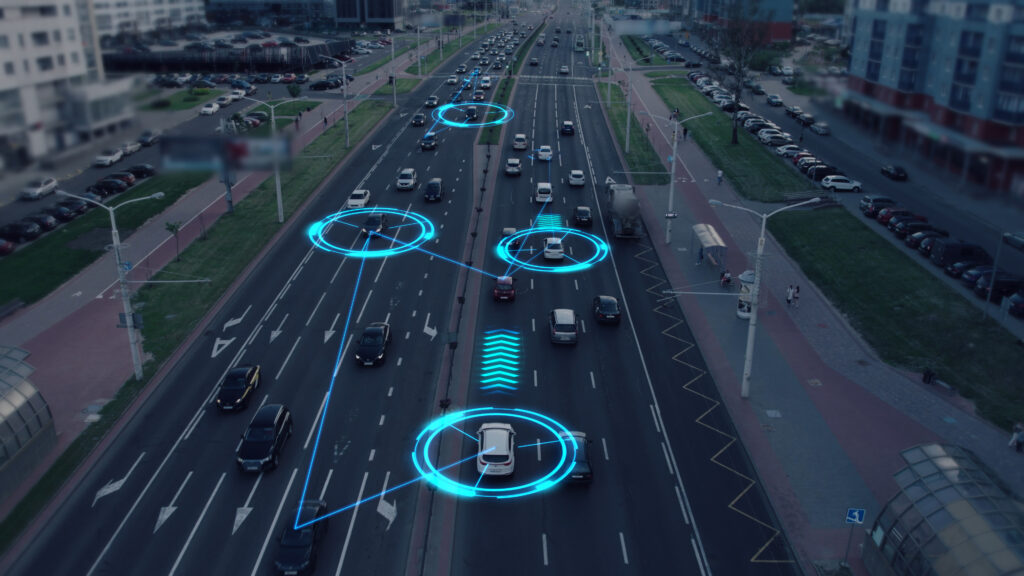 Similar to when the first automobiles traveled alongside horses and buggies, autonomous vehicles (AVs) and human-driven vehicles (HVs) must someday share the same road. How to best manage this transition is the topic of a new Carnegie Mellon University policy brief, ‘Mixed-Autonomy Era of Transportation: Resilience & Autonomous Fleet Management.’ Carlee Joe-Wong, the Robert E. Doherty Career Development Professor of Electrical and Computer Engineering at CMU, shares her thoughts with AAVI on how this might play out.
Similar to when the first automobiles traveled alongside horses and buggies, autonomous vehicles (AVs) and human-driven vehicles (HVs) must someday share the same road. How to best manage this transition is the topic of a new Carnegie Mellon University policy brief, ‘Mixed-Autonomy Era of Transportation: Resilience & Autonomous Fleet Management.’ Carlee Joe-Wong, the Robert E. Doherty Career Development Professor of Electrical and Computer Engineering at CMU, shares her thoughts with AAVI on how this might play out.
The past decade has unquestionably advanced a vision of fully autonomous vehicles (AVs) enabled by artificial intelligence, Internet of Things (IoT) systems and driver-assist technologies. Indeed, vehicles with varying degrees of autonomy are already being deployed in the United States, e.g. as taxi services on the streets of San Francisco or as fleets of self-driving trucks on freeways.
Transportation research studies often aim to anticipate how AVs will change the dynamics of transportation networks. However, analyses of AVs’ effects on traffic flow generally do not account for mixed autonomy settings, in which autonomous vehicles share the road with human-driven vehicles (HVs). Realistically, AVs will share the roads with human-driven cars for some time. While today only a small fraction of vehicles are autonomous (i.e. not under human control), AVs’ increasing technical feasibility points toward them gradually being deployed in more and more locations and in greater numbers. We need to ready ourselves for this hybrid, human-driven and AV transportation future by studying this phenomenon and preparing policies now so that we can effectively manage this transition.
In my research, my colleagues and I examined how AVs could interact with human drivers and offered broad policy suggestions. We reviewed the benefits of AVs in transportation networks in terms of their potential to operate at greater densities and consequently achieve lower travel times and energy consumption. AVs are equipped with multiple sensors and use computers to automatically detect and respond to changes on the road. AVs could thus safely and closely follow each other to generate a denser traffic flow. AVs can also be programmed to make collaborative decisions that reduce overall traffic congestion, even if some vehicles experience greater delays as a result. Indeed, the communication capabilities of AVs will enable vehicle-to-vehicle and vehicle-to-infrastructure communications that will allow AVs to re-route themselves further along their planned routes in anticipation of incidents, like accidents or road construction, that may not be visible to human drivers until it is too late to avoid them. The combination of these factors will keep traffic flowing more smoothly.
But how will the benefits of self-driving cars come to fruition with human drivers on the road? Mapping applications like Waze can already anticipate future slowdowns on a vehicle’s route and suggest re-routing accordingly. To get to the crux of this question, we therefore asked: ‘What is different when AVs share roads with HVs?” We realized that an important distinction between AVs and HVs is that, generally speaking, AVs are altruistic and human drivers are selfish.
Selfish by nature
When driving, humans usually behave selfishly, choosing their travel routes and driving decisions so as to achieve some combination of minimizing their travel times, maximizing their fuel efficiency and prioritizing their own needs (e.g. avoiding freeways if the driver is uncomfortable driving on such roads). AVs, on the other hand, could make collaborative routing and speed-of-travel decisions that seek to benefit all vehicles. Programmed to operate safely and follow rules, AVs can take altruistic actions that benefit other vehicles and not just themselves, even it if means taking a longer route to their destinations. Humans in a hurry may not be so generous with their time.
The cost of selfish driving becomes evident when examining traffic flow. As selfishly behaving cars move in and out of a traffic system, eventually the system reaches equilibrium, a balanced state, but traffic may not be flowing as efficiently as it could. Sometimes the equilibrium is far from optimum. For example, an equilibrium can be reached when traffic snarls along bumper to bumper. What we discovered is that the altruism displayed by AVs could improve traffic flow by avoiding suboptimal equilibria, and that not everybody has to act altruistically to improve travel times. In simulations, altruistic states come into play when AVs make up 20% to 50% of the vehicles on the road – far from today’s reality but conceivable within the next decade, at least in certain areas. This is an important point for policymakers because they could enact policies that would reward altruism. AV users could receive toll exemptions, parking discounts and other forms of incentive to encourage altruistic behavior.
Dynamic fleet management
Another area where smart policy could come into play pertains to dynamic fleet management. AVs have the capacity to work in sync, but trying to centrally control thousands of AVs will lead to computation issues and communication delays. We discovered that reinforcement learning, a machine learning training method, can help us strike a balance between centralized and decentralized policies. In some traffic situations, one truly needs reinforcement learning intelligence along with increased communications between the operating network and other vehicles. But this isn’t the case all the time. Our work suggests that transportation operators should train models to manage AV fleets locally. If new traffic patterns occur, then the models are updated, especially to direct people away from incidents. However, if traffic flows unabated, then fewer updates are needed and AV communications to centralized servers and to each other are reduced, easing computational and network communication burdens.
Policymakers should also consider the resilience of transportation systems to sudden disruptions, such as severe wrecks that could cause traffic jams that quickly spread from the accident and throughout the road system. Natural disasters, like earthquakes or flash floods, could similarly trigger a process called cascading failure, which eventually could cause the whole road network to break down as congestion proliferates through the entire road network.
We conjecture that AVs can help prevent cascading failures by responding to hazards quicker than HVs and redistributing traffic away from roads likely to become congested. For example, they could use their knowledge of current traffic conditions throughout the system to identify which roads are close to capacity or likely to become congested, and they could alert traffic managers or take action themselves to mitigate cascading congestion.
AV data could also inform traffic managers about other forms of transportation in the network that could work in tandem to avoid cascading failures. When researching this topic, in addition to AVs and HVs, we included bus, subway, railway and bike-sharing systems in our models. We demonstrated that if passengers could switch between varying modes of transportation, this would maximize the use of the transportation network as a whole (including roads as well as public transit) and prevent it from overloading due to cascading failures. These results signal that it would be advantageous for planning agencies to create AV traffic flow policies that incorporate the presence of multiple interdependent transportation systems to keep people moving and that jointly consider current traffic levels across these different modes of travel.
Creating far-reaching policies today for future AVs could be difficult to sell to a skeptical public. Public perception and acceptance of self-driving cars is not clear, and acceptance is needed to make any new technology take hold. Yet, self-driving cars with varying levels of autonomous technologies and safety drivers are deployed now. In the United States, more than half of the states have enacted legislation related to AVs.
Take the initiative
Technology development continues to make driving safer as the auto industry pushes us toward eliminating human drivers. Who knows if humans will ever be totally out of the equation, but what is inevitable is that cars with varying levels of autonomous driving capacity will be sharing the roads. It would behoove us to get in front of this issue and learn what benefits can be derived from mixed autonomy on our highways, so that we can develop policies and regulatory structures that will keep people traveling safely and efficiently regardless of whether a person is behind the steering wheel or not.


